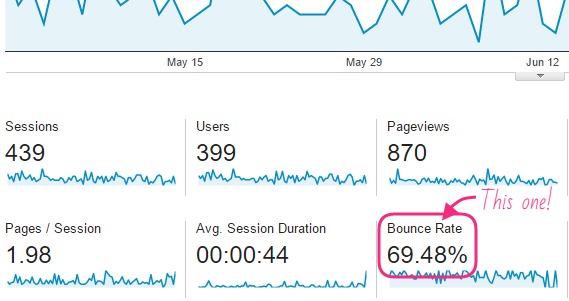We all know it:
A high bounce rate is bad! Right??
Well, that depends. On a lot, actually.
And even if you decide you need to “get your bounce rate down”, you first need to have a deeper understanding of what causes bounces than just “bounce = bad”.
Let’s have a look at what a bounce rate really is and what a “bounce” means for different parts of your online shop.
Forget your average bounce rate
The first thing you can do is ignore your average bounce rate for your whole shop.
Bounces mean different things for different types of pages, so averaging it over the whole site is actually pretty useless and worse: distracting.
Sure, you can keep an eye on it. If it goes up drastically, you should find out why. But your average bounce rate alone doesn’t tell you whether your shop is performing well or poorly.

What exactly IS a “bounce”?
A bounce is a visit to your website that does not “engage”.
The exact definition is different between Google Analytics 4 (GA4) and Universal Analytics (UA), because engagement is defined differently!
Engagement happens when the visitor triggers some kind of event. In UA, page views are the only standard event tracked, so traditionally, a bounce was a visit consisting of only one page view before they left the website completely. In GA4, more events are tracked by default, including viewing a page for 10 seconds. This means that some single-page visits might still count as “engaged” and not as a bounce, reducing the bounce rate.
So we know that a bounce = an “un-engaged visit”. That doesn’t sound like a good thing, and often it’s not. But let’s have a think about the different scenarios that might result in a bounce.
What causes a visitor to bounce?
There are a few things that contribute to a high bounce rate, no matter what page they’re visiting, device they’re using or source they came from.
- Confusing or un-credible website design. Visitors give up quickly if information (like prices) or functionality (like the cart) is hard to find or use. Likewise, if the site overall feels out of date, unmaintained or low quality, it can make it hard for visitors to trust that your site is secure and products reliable.
- Slow loading times. Watch out for how various tools and plugins impact your shop’s loading time. Test it out on your mobile phone data plan with poor reception!
Home page bounce rate
First up – no, a bounce on your shop home page is not good. The ultimate goal of your shop home – no matter what ecommerce platform you use – is to send people to your products so they can buy them. If a visitor doesn’t get past the home page, then they definitely aren’t adding anything to their cart!
- Make is super obvious what you sell.
- Connect quickly (via concise messaging and imagery) with your target audience.
- Give the visitor plenty of opportunities to view actual products: featured items, your latest collection and a prominent search bar are all good ways to help them move to product pages fast.
Well, do I want a low bounce rate or not??
At a basic level, yes, you want to reduce your bounce rate. But what you can actually learn from the bounce rate varies depending on the type of page you’re analysing.
A bounce on your shop home means something different to a bounce on a listing.
I recommend only paying attention to the bounce rate of individual pages or pages that are all the same type. So forget about your site average and start diving a bit deeper!

